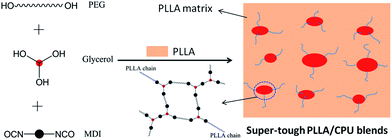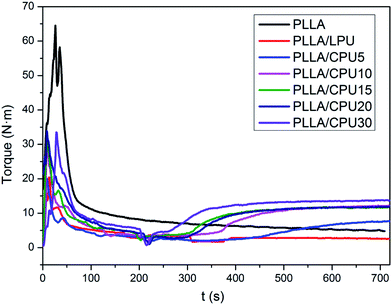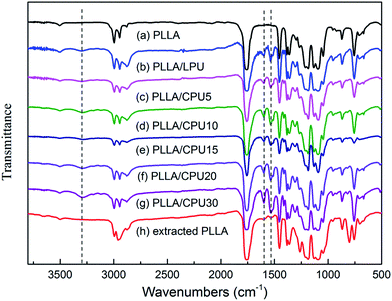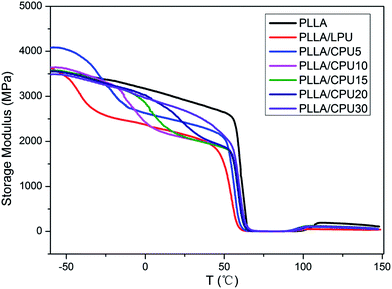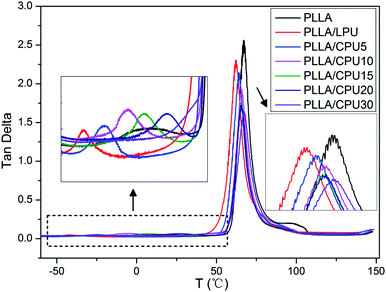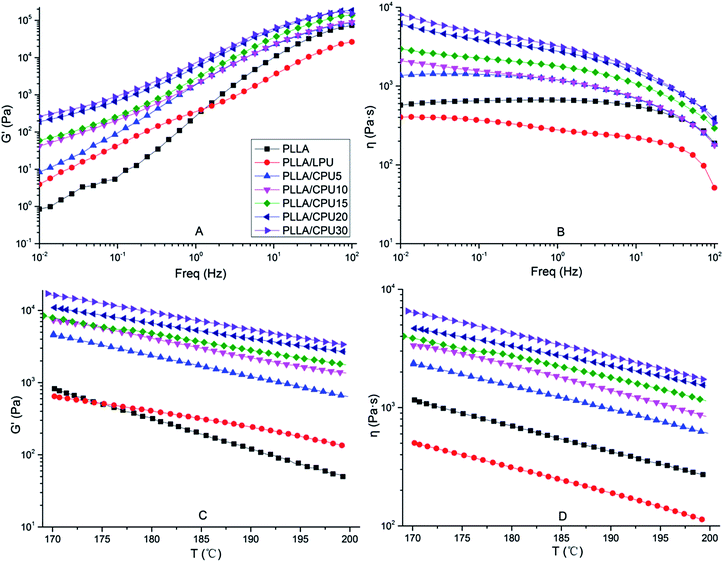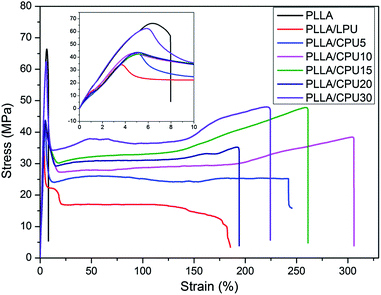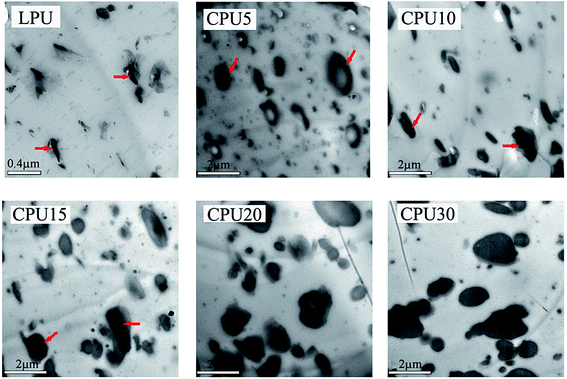Super-tough poly(L-lactide)/crosslinked polyurethane blends with tunable impact toughness
Yi-Song He,
Jian-Bing Zeng*,
Guang-Chen Liu,
Qiu-Tong Li and
Yu-Zhong Wang*
Center for Degradable and Flame-Retardant Polymeric Materials (ERCPM-MoE), College of Chemistry, State Key Laboratory of Polymer Materials Engineering, National Engineering Laboratory of Eco-Friendly Polymeric Materials (Sichuan), Sichuan University, Chengdu 610064, China. E-mail: zengjianbing@scu.edu.cn; yzwang@scu.edu.cn
First published on 24th February 2014
Abstract
Super-tough poly(L-lactide)/crosslinked polyurethane (PLLA/CPU) blends with a CPU phase dispersed in the PLLA matrix were prepared by reactive blending of PLLA with poly(ethylene glycol) (PEG), glycerol, and 4,4′-methylenediphenyl diisocyanate (MDI). The gel fraction increased while the swelling ratio decreased with increasing glycerol content. FT-IR analysis suggests that interfacial compatibilization between PLLA and CPU occurred via reaction between the hydroxyl group of PLLA and the isocyanate group of MDI. The elongation at break and notched impact strength of PLLA/CPU blends were increased by up to 38 and 21 times those of neat PLLA. The morphology of PLLA/CPU blends plays an important role in notched impact strength and can be controlled by adjusting the content of glycerol. The size of the dispersed CPU phase increased gradually while the notched impact strength increased first and then decreased with increasing glycerol content. Therefore, the notched impact strength can be easily tailored by the content of glycerol of CPU. The optimum size for high impact strength was found to be ∼0.7 μm, which was obtained for the blends with glycerol content in the range of 5 to 10 wt% on the basis of PEG weight. In addition, the effect of glycerol content on the compatibility and rheological properties of PLLA/CPU blends was also investigated.
1. Introduction
Biobased and biodegradable polymers have attracted increasingly attention due to the sustainable and environmental concerns with respect to traditional non-degradable petroleum-based polymers.1–7 Poly(L-lactide) (PLLA), which is derived from annually renewable resources,8 is regarded as one of the most promising biobased and biodegradable polymers because of its excellent biocompatibility, high mechanical strength, easy processibility, and high melting temperature. It has the potentiality to be widely used in many areas such as biomedical devices, packaging, disposable tableware, fibers, and consumer goods. However, the further application of PLLA in substituting commodity plastics such as polyethylene or polypropylene was significantly restricted by its inherent brittleness, as evidenced by the limited elongation at break and low impact strength.In order to expand the application of PLLA, many approaches such as chemical copolymerization and physical blending have been developed to improve the toughness of PLLA.9–12 Although chemical copolymerization with other flexible polymer components is efficient to synthesize copolymers with improved extensibility, the other excellent physical properties are also changed since the chemical structures of the copolymers are much different from PLLA homo-polymer, which is not preferred for practical application. In addition, the chemical copolymerization was relatively complicated and thus not economic. In contrast, physical blending provides an economic and effective way to modify the properties of PLLA. The excellent properties do not change since the chemical structure of PLLA is kept during physical blending. Therefore, a lot of flexible polymers of both biodegradable and non-biodegradable have been employed to blend with PLLA to improve its toughness, including poly(butylene succinate),13–15 poly(ε-caprolactone),16–18 bacterial polyesters,19,20 poly(butylene adipate-co-terephthalate),21,22 polyurethane,23,24 hyperbranched polymer,25 acrylonitrile-butadiene-styrene copolymer,26 polyethylene,27,28 poly(ethylene oxide),29,30 poly(oxymethylene),31 thermoplastic polyolefin elastomer,32,33 and bioelastomer.34 Unfortunately, although the blends of PLLA with most of those polymers showed considerable enhancement in elongation at break, the improvement in impact strength was very limited due to the poor compatibility between the blend systems. The compatibility of blends can be improved by adding suitable block or graft copolymers; however, the improvement in impact toughness was still not so satisfied due to the fact that the improvement in compatibility is insufficient.
Super-tough PLLA materials were occasionally reported in literatures. Oyama35 reported super-tough PLLA blends with poly(ethylene-glycidyl methacrylate) (EGMA) prepared through reactive blending, which showed impact strength superior to benchmark acrylonitrile-butadiene-styrene (ABS) resins. Dong et al.36 reported PLLA microalloys and nanoalloys with excellent impact strength by reactive blending of PLLA and ethylene-co-acrylic ester-co-glycidyl methacrylate (E-AE-GMA) rubber. The interfacial compatibilization of PLA and E-AE-GMA took place by terminal functional reaction and the size of dispersed E-AE-GMA could be controlled by reactive blending time and both microalloys and nanoalloys could be obtained. The dispersed phase size played an important role in the impact strength on the PLLA alloys and the results suggested that the PLLA microalloys showed higher impact strength. Liu et al.37,38 reported super-tough PLA ternary blends by simultaneous dynamic vulcanization and interfacial compatibilization. During reactive blending, the formation of elastomeric ethylene-butyl acrylate-glycidyl methacrylate terpolymer (EBA-GMA) dispersed phase was catalyzed by carboxyl groups of zinc ionomer of ethylene-methyacrylic acid copolymer (EMAA-Zn), and the interfacial compatibilization between PLLA and EBA-GMA phases happened by the reaction of epoxy groups of EBA-GMA and terminal groups of PLLA which was catalyzed by the zinc ions of EMAA-Zn at elevated reactive blending temperature, which is responsible for the result that the ternary blends formed at elevated temperature showed higher impact strength.
Recently, we developed a way of toughening PLLA by formation of PLLA/crosslinked polyurethane (PLLA/CPU).39 In this paper, we report a novel way of tailoring physical properties of super-tough PLLA/CPU blends through adjusting the crosslinking density of in situ formed CPU. The crosslinking density of CPU can be controlled by the feeding content of trifunctional monomer glycerol, which in turn affects the phase morphologies of PLLA/CPU blends, and thus the physical properties especially the impact toughness can be well tuned.
2. Experimental section
2.1 Materials and sample preparation
PLLA (4032D) was purchased from Natureworks. The Mw and Mw/Mn determined by GPC in chloroform were 4.71 × 105 g mol−1 and 2.25, respectively. PEG with molecular weight of 1000 g mol−1 and glycerol were supplied by KeLong Chemical Corporation (Chengdu, China). 4,4′-Methylenediphenyl diisocyanate (MDI) was attained from Alfa Aesar. All the materials were used without further purification but vacuum dried prior to sample preparation. Reactive melting blending was carried out in an internal mixer (Haake Rotation Rheology) at 190 °C with a rotor speed of 50 rpm. PLLA, PEG and glycerol were premixed for 4 min, and then MDI was added, the reaction was finished when the torque kept unchanged. For all the samples the fraction of PLLA was kept at 80 wt% based on the total blend weight. The feed ratio of PEG to glycerol shifted from 100/0 to 100/5, 100/10, 100/15, 100/20 and 100/30. The amount of MDI was determined by the total hydroxyl groups of PEG and glycerol, i.e., the molar ratio of isocyanate groups to total hydroxyl groups of PEG and glycerol was kept at 1![[thin space (1/6-em)]](https://www.rsc.org/images/entities/char_2009.gif) :
:![[thin space (1/6-em)]](https://www.rsc.org/images/entities/char_2009.gif) 1. When there was no glycerol, the obtained polyurethane was almost linear, thus the sample was marked as PLLA/LPU. The other samples were marked as PLLA/CPU5, PLLA/CPU10, PLLA/CPU15, PLLA/CPU20, and PLLA/CPU30, where the number behind CPU represents the content of glycerol weight fraction in the hydroxyl containing reactants. For properties comparison, neat PLLA was also subjected to the mixing treatment so as to have the same thermal history as the blends.
1. When there was no glycerol, the obtained polyurethane was almost linear, thus the sample was marked as PLLA/LPU. The other samples were marked as PLLA/CPU5, PLLA/CPU10, PLLA/CPU15, PLLA/CPU20, and PLLA/CPU30, where the number behind CPU represents the content of glycerol weight fraction in the hydroxyl containing reactants. For properties comparison, neat PLLA was also subjected to the mixing treatment so as to have the same thermal history as the blends.
2.2 Gel fraction measurement
The samples with weight W1 were immerged in chloroform and stirred at 50 °C for 8 h. PLLA is soluble while the crosslinked CPU is insoluble in chloroform. Therefore, the crosslinked CPU can be separated from the solution by ultracentrifugation at 8000 rpm for 15 min. The obtained products were dried for 24 h in 40 °C vacuum oven and weighed (W2). The gel fraction (f) can be calculated from the following equation:
 | (1) |
2.3 Swelling test
The blend slice (W1) was immerged in distilled water at 70 °C for 48 h to reach equilibrium water absorption. The surface water was wiped with filtered paper and weighed (W2) and the sample was then dried in 40 °C vacuum oven for 24 h and the final weight was weighed as W3. The weight loss (WL) was calculated by
 | (2) |
The swelling ratio (SR) of CPU was calculated by
 | (3) |
2.4 Fourier transform infrared spectroscopy (FT-IR)
The sample films for FT-IR measurement (NICOLET 6700) were prepared by casting their chloroform solutions on clear glass plates. FT-IR spectra were recorded on a Fourier transform infrared spectrometer in a range of wave numbers from 4000 to 400 cm−1. The resolution and scanning time were 4 cm−1 and 32 times, respectively.2.5 Mechanical properties measurements
Specimens for mechanical test were injection molded at melt temperature of 200 °C and mold temperature of 60 °C. The tensile test was performed at room temperature and crosshead speed of 5 mm min−1, using a universal testing machine (Instron 5567), following ASTM D638. Notched Izod impact test was carried out on a Sansi ZBC-50 impact tester according to ASTM D256. The average values of at least five specimens were reported for all samples.2.6 Gel permeation chromatography (GPC)
The molecular weight and polydispersity index of PLLA before and after processing were measured by GPC, using a Waters instrument equipped with a model 1515 pump, a Waters model 717 autosampler and a 2414 refractive index detector. The samples were dissolved in chloroform. The crosslinked polyurethane was removed by filtration, and PLLA was precipitated by after adding excessive methanol to the filtered solution. The precipitates were vacuum dried at 80 °C for 24 h prior GPC test.2.7 Dynamic mechanical analysis (DMA)
Dynamic mechanical properties of the samples were measured with DMA Q800 (TA Instruments) in a single-cantilever mode with an oscillating frequency of 1 Hz. The test was carried out at a heating rate of 3 °C min−1 from −70 to 150 °C.2.8 Rheological property measurement
Neat PLLA and blends were conducted with a parallel plate rheometer (Bohlin Gemini 200) in dynamic strain frequency sweep mode from 0.01 to 100 Hz at 180 °C and in dynamic temperature sweep mode from 170 to 200 °C at 1 Hz.2.9 Scanning electron microscopy (SEM)
The morphologies of blends were examined by scanning electron microscopy (JSM-5900LV, JEOL) at an accelerating voltage of 5 kV. The injection-molded bars were cryofractured in liquid nitrogen, and the fractured surfaces were sputter-coated with a thin layer of gold prior to examination. The fractured surfaces after impact test were also observed using the same SEM apparatus.2.10 Transmission electron microscopy (TEM)
The morphology and size of dispersed phase were characterized by TEM (Tecnai G2 F20 S-TWIN) at an accelerated voltage of 100 kV. Image J analysis software was used to analyze the particles from at least six independent TEM images, and we calculated weight-average particle diameter (dw) using the following equation:40
 | (4) |
3. Results and discussion
3.1 Sample preparation and characterization
PLLA/CPU blends were prepared by reactive blending. The CPU was formed by in situ polymerization of PEG, MDI and glycerol, as shown in Scheme 1. For property comparison, PLLA blends with linear polyurethane (PLLA/LPU) were also prepared by reactive blending of PLLA with PEG and MDI, and the neat PLLA was also treated with the same processing procedure. The processing was carried out in a torque rheometer. The melt torque versus processing time was recorded, as shown in Fig. 1. For the preparation of the blends, MDI was added into the chamber after premixing of PLLA, PEG and glycerol. Accordingly, the change of torque included two steps. In the first step, a decrease in torque was observed due to the melting of PLA pellets and the plasticization of PLA by PEG during premixing; when MDI was added (at 4 min), the torque increased gradually in the initial stage of the second step, suggesting the polymerization of PEG, glycerol and MDI; the torque increased to a stable platform with the blending time further increased, marking the completion of the reaction. In contrast, the torque of neat PLA decreased during the whole blending process. It is worth noting that the final torque of the samples showed an uptrend with increasing glycerol content. The crosslinking density of CPU increased with glycerol content, which would reduce the chain mobility of the samples.In order to prove the formation of polyurethane by reactive blending, the FT-IR spectra of the blends were recorded and compared with that of neat PLLA. Fig. 2 shows the FT-IR spectra of the samples. By comparing the spectrum of neat PLLA with those of the blends, three new absorption peaks around 3300, 1600 and 1530 cm−1 were observed for all blends. They were ascribed to the characteristic absorptions of N–H bond, conjugated double bonds of benzene ring and urethane linkage, respectively, suggesting the formation of polyurethane in the blends during blending. It is known that the characteristic absorption peak of isocyanate group exists at around 2270 cm−1. However, it could not be detected in the spectra of the blends, indicating a complete consumption of diisocyanates during blending.
In order to confirm crosslinked polyurethane formed during reactive blending, the gel fractions (f) of the blends were measured accordingly to the method as mentioned in Section 2.2. The results are listed in Table 1. There was no gel for neat PLLA and PLLA/LPU blend, suggesting that no crosslinked products formed. While for PLLA/CPU blends, gel was obtained and its content increased slight with increasing glycerol content, indicating that increasing CPU formed. We found that the gel fraction of CPU was somewhat less than the theoretical value according feeding content (20%), which suggests that there might be some non-crosslinked products such as branched PU or free PEG existed in the blends. This is possible since the feeding molar ratio NCO of MDI to OH of glycerol and PEG was 1![[thin space (1/6-em)]](https://www.rsc.org/images/entities/char_2009.gif) :
:![[thin space (1/6-em)]](https://www.rsc.org/images/entities/char_2009.gif) 1, and some NCO groups may be consumed by terminal groups of PLLA, thus some OH groups of glycerol or PEG should remain to form some non-crosslinked products.
1, and some NCO groups may be consumed by terminal groups of PLLA, thus some OH groups of glycerol or PEG should remain to form some non-crosslinked products.
| Sample | Gel fraction (%) | Weight loss (%) | Swelling ratio (%) |
|---|---|---|---|
| PLLA | 0 | 0 | 0 |
| PLLA/LPU | 0 | 7.7 ± 0.9 | 43.1 ± 11.6 |
| PLLA/CPU5 | 13.4 ± 0.3 | 4.0 ± 0.7 | 24.4 ± 5.5 |
| PLLA/CPU10 | 13.8 ± 0.2 | 2.3 ± 0.6 | 13.4 ± 3.7 |
| PLLA/CPU15 | 15.7 ± 0.4 | 0.7 ± 0.6 | 4.0 ± 1.6 |
| PLLA/CPU20 | 15.6 ± 0.3 | 0.7 ± 0.3 | 3.4 ± 0.7 |
| PLLA/CPU30 | 16.8 ± 0.5 | 0.2 ± 0.2 | 3.0 ± 0.5 |
The crosslinking density of CPU can be evaluated qualitatively by swelling ratio. The sample with higher crosslinking density should show smaller swelling ratio, since the access of solvent into the higher crosslinked polymer become more difficult. It is well know that water is a good solvent for PEG, therefore the swelling ratios of the samples were tested in 70 °C water. The temperature is higher than Tg of PLLA, which would be helpful for water to diffuse into the samples. Because the swelling ratio of neat PLLA was 0, the swelling ratio (SR) was considered based on the content of CPU. The swelling ratio of CPU decreased gradually with increasing glycerol content suggesting an increasing crosslinking density. During swelling ratio test, we found that weight loss (WL) occurred for the samples, and the value of WL decreased significantly with increasing glycerol content. Those dissolved part should be free PEG, which remains due to some NCO groups reacted with PLLA as discussed in following. However, the content of remained PEG was very limited especially for the samples with glycerol content of more than 15 wt% based on PEG weight. The effect of limited amount of free PEG on the properties of PLLA/CPU should be neglected although it can act as plasticizer to PLLA.
For biodegradable aliphatic polyesters, the molecular weight usually decreases after thermal processing and thus results in performance deterioration. In this study, we measured the molecular weight of PLLA after blending. The results are listed in Table 2. The weight average molecular weight (Mw) of neat PLLA decreased slightly from 4.71 × 105 to 4.59 × 105 g mol−1 after thermal processing. For PLLA/LPU blend, the Mw value of PLLA decreased obviously to 4.03 × 105 g mol−1, while in the case of PLLA/CPU blends, the Mw values of PLLA did not decrease or even increased after blending, which was ascribed to the possible chain linking reaction of MDI with the terminal hydroxyl group of PLLA. The reaction of MDI with PLLA would also improve the compatibility between CPU and PLLA phases, which would be helpful for improving properties of the resulting materials. In order to confirm the reaction between PLLA and MDI, PLLA was extracted from PLLA/CPU blends and characterized by FT-IR, as shown in Fig. 2h. Not only the absorption peaks at 1600 and 1530 cm−1 were observed, the absorption peak at 801 cm−1 ascribed to the characteristic absorptions of the out-plane bending vibration of C–H bonds of benzene ring was also observed, indicating the occurrence of reaction between PLLA and MDI.
| Sample | Tg,PUa (°C) | Tg,PLLAa (°C) | Mwb (105 g mol−1) | Tensile strength (MPa) | Elongation at break (%) | Tensile modulus (MPa) | Notched impact strength (J m−1) |
|---|---|---|---|---|---|---|---|
| a Determined by DMA.b Weight average molecular weight of extracted PLLA determined by GPC. | |||||||
| PLLA | 67.0 | 4.59 | 64.9 ± 2.7 | 8.0 ± 0.9 | 2001.6 ± 71.0 | 16.9 ± 1.4 | |
| PLLA/LPU | −40.9 | 62.4 | 4.03 | 31.1 ± 0.4 | 181.1 ± 50.5 | 1563.8 ± 25.4 | 126.5 ± 25.8 |
| PLLA/CPU5 | −24.4 | 63.9 | 4.71 | 43.2 ± 0.4 | 236.7 ± 2.1 | 1584.9 ± 29.3 | 322.5 ± 41.1 |
| PLLA/CPU10 | −5.1 | 65.4 | 5.33 | 43.2 ± 0.1 | 303.1 ± 7.5 | 1568.8 ± 70.1 | 407.6 ± 39.8 |
| PLLA/CPU15 | 9.4 | 65.3 | 6.14 | 43.8 ± 3.6 | 266.8 ± 31.8 | 1531.4 ± 62.9 | 109.6 ± 8.2 |
| PLLA/CPU20 | 26.1 | 65.8 | 4.94 | 43.8 ± 1.2 | 201.0 ± 34.6 | 1578.9 ± 126.2 | 39.4 ± 4.1 |
| PLLA/CPU30 | 50.0 | 67.0 | 6.20 | 61.7 ± 4.2 | 203.5 ± 18.2 | 1874.5 ± 41.9 | 28.6 ± 1.8 |
Dynamic mechanical analysis (DMA) was used to study the effect of composition of CPU (namely the content of glycerol in CPU) on the compatibility of PLA/CPU blends. Fig. 3 and 4 show the storage modulus and tan delta as a function of temperature for the samples, respectively. From Fig. 3, it can be seen that the storage modulus of neat PLLA below 70 °C was higher than that of the blends, which was reasonable since the stiffness of the sample should decreased after blending with polyurethane that has relatively lower storage modulus than neat PLLA. A considerable drop in storage modulus of neat PLLA was observed at 67 °C corresponding to its glass transition temperature (Tg, α-relaxation). For the blends, two decreases in storage modulus can be observed. The decrease in higher temperature range was attributed to the α-relaxation of PLLA while that in lower temperature was ascribed to the α-relaxation of CPU. Accordingly, two relaxation peaks can be observed on the tan delta plots. The Tg values of the both phases could be obtained from the tan delta plots, the results are summarized in Table 2. For the effect of glycerol content on the glass transition temperature of the both components, we can see that the Tg of PLLA component increased gradually 62.43 °C to 67.02 °C with the content of glycerol in CPU increasing from 0 wt% to 30 wt%. The results are ascribed to the fact that the soft PEG segment decreased gradually with increasing glycerol and thus the plasticization effect of CPU to PLLA decreased accordingly. The Tg of the polyurethane component also increased with glycerol content, from −42.43 °C in PLLA/LPU blend to approximate 50 °C in PLLA/CPU30 blend. The trend is reasonable because both the crosslinking density and the hard segment content of polyurethane increased thus the chain mobility decreased with increasing glycerol content. In addition, we can see that the α-relaxation peak intensity of PLLA in the blends was lower than that of neat PLLA and became lower with increasing glycerol content, which was due to that the mobility of PLLA chains was gradually inhibited by CPU network with increasing crosslinking density. From the above discussion, we can conclude that phase separation between the two phases occurred and the compatibility decreased with increasing glycerol content due to the decreased plasticization effect of CPU to PLLA.
In order to further study the effect of crosslinking density of CPU on the chain mobility of PLLA, the rheological behaviors of neat PLLA and its blends were investigated by a parallel plate rheometer. Fig. 5A and B show the variation of storage modulus (G′) and complex viscosity (η) with oscillatory frequency for the samples. PLLA/CPU blends showed higher storage modulus and complex viscosity than neat PLLA and PLLA/LPU blends in the full frequency regions, which was ascribed to the formation of CPU crosslinking network that make the mobility of the polymer chains more difficult, and relatively higher molecular weight of PLLA in PLLA/CPU than that of neat PLLA and PLLA in PLLA/LPU. For the effect of glycerol content, the storage modulus and complex viscosity increased distinctly with glycerol content of CPU, which was ascribed to the increased crosslinking density of CPU. It is reported that the presence of cross-links or entangled networks in a polymer melt could increase the modulus and viscosity.41 Therefore, the improvement in storage modulus and complex viscosity was ascribed to the formation of CPU crosslinking network. In contrast, crosslinking network was absent in PLLA/LPU, thus it showed much lower storage modulus and complex viscosity in comparison with PLLA/CPU. Similar results were also obtained in dynamic temperature sweep mode, as shown in Fig. 5C and D. The storage modulus and complex viscosity increased with glycerol content in the whole temperature regions involved in this study. The viscosity of PLLA/LPU was lower than neat PLLA, which should be attributed to the plasticization effect of LPU to PLLA and the relatively lower molecular weight of PLLA in PLLA/LPU.
3.2 Mechanical properties
The mechanical properties including tensile property and impact strength of the samples were investigated. Fig. 6 shows the stress–strain curves of neat PLLA and the blends and Table 2 summarizes the important mechanical property parameters. Neat PLLA showed the typical character of brittle fracture without obvious yielding and with respective elongation at break and tensile strength of 8% and 64.85 MPa. While all the blends showed characteristic nature of ductile fracture. An apparent yielding could be observed in the stress–strain curves of all the blends. The elongation at break of the blends were more than 181%, which were much higher than that of neat PLLA, indicating a significant improvement in tensile toughness by blending with the in situ formed polyurethane. It is more interesting to study the effect of polyurethane composition, i.e., the content of glycerol in the polyurethane, on the mechanical properties of the samples. For PLLA/LPU, there was no glycerol unit in the polyurethane; the major component of LPU was PEG which acted as plasticizer for PLLA. Therefore, the elongation at break increased remarkably to 181% while the tensile strength decreased remarkably to 31.09 MPa in comparison with neat PLLA. After glycerol was introduced to the polyurethane, the tensile strength of PLLA/CPU was much higher than PLLA/LPU and almost kept unchanged at around 43 MPa when the content of glycerol was not more than 20 wt%, while when the content of glycerol increased to 30 wt%, the tensile strength increased remarkably to 61.74 MPa (PLLA/CPU30), which was very close to that of neat PLLA. It is worth noting that the elongation at break of PLLA/CPU samples are higher than that of PLLA/LPU, and the value of elongation at break increased first and then decreased with glycerol content, the maximum was observed for PLLA/CPU10 in which the content of glycerol was 10 wt% on the basis of PEG weight. In the case of tensile modulus, when glycerol content was not more than 20 wt% the tensile modulus of PLLA/CPU was close to that of PLLA/LPU with the values of around 1550 MPa, which was about 3/4 that of neat PLLA (2000 MPa), while when the glycerol content increased to 30 wt%, the tensile modulus increased to approach that of neat PLLA with the value of 1874 MPa.The notched Izod impact strength was measured to study the effect of glycerol on the impact toughness of PLLA blends. The results are shown in Table 2. Neat PLLA also showed a character of brittle fracture with the impact strength of only 16.9 J m−1. The impact strength of PLLA/LPU was 126.5 J m−1 which was about 8 times that of neat PLLA. After introduction of glycerol to the polyurethane, the impact strength increased remarkably when the content of glycerol was not more than 10 wt%, for example, PLLA/CPU10 had impact strength of 407.6 J m−1 which was 24 times that of neat PLLA. However, when the content of glycerol further increased, the impact strength underwent notable reduction, especially when the content of glycerol was 30 wt%, the impact strength of PLLA/CPU30 decreased to 28.6 J m−1 which was approaching to that of neat PLLA.
In order to study the reason for the different impact strengths of the samples with different compositions, the morphologies for impact fracture surfaces of the samples were observed by SEM, as shown in Fig. 7. Neat PLLA showed smooth surface with only a few local shear zones, suggesting brittle fracture corresponding to the low impact strength. The impact fractured surfaces of PLLA/LPU and PLLA/CPU blends showed a remarkable difference from that of neat PLLA. PLLA/LPU showed much rougher surface with more shear zones than neat PLLA. There were not only the shear zones but also many fibrils on impact fracture surface of PLLA/CPU10, suggesting the occurrence of extensive plastic deformation through shear yielding of the PLLA matrix. The formation of such surface would absorb more impact energy and thus show higher impact strength. When the content of glycerol was further increased, the extensive plastic deformation decreased gradually, and for PLLA/CPU30 the plastic deformation even vanished, which was corresponding to the dramatically dropped notched impact strength.
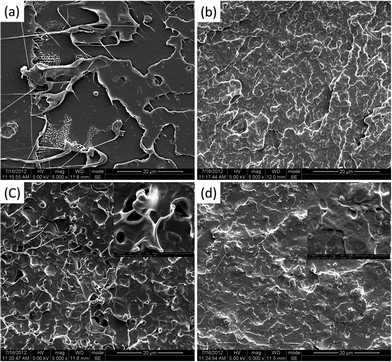 | ||
Fig. 7 SEM images of impact fractured surfaces for neat PLLA (a), PLLA/LPU (b), PLLA/CPU10 (c), and PLLA/CPU30 (d). High magnification of 40![[thin space (1/6-em)]](https://www.rsc.org/images/entities/char_2009.gif) 000 was inserted. 000 was inserted. | ||
The above results suggest that the content of glycerol plays a critical role in the mechanical properties of the PLLA blends. For PLLA/LPU, the LPU was obtained by reaction of PEG and MDI, the main component was PEG, which was usually used as a plasticizer for PLLA. Therefore, the improvement in toughness of PLLA/LPU could be mainly ascribed to the plasticization effect of LPU which was evidenced by the obvious reduction in Tg of PLLA component as discussed in Section 3.1. But in the cases of PLLA/CPU samples, the improvement in toughness could not be simply attributed to the plasticization effect since the reduction in Tg of PLLA component was very limited. The addition of a trifunctional monomer glycerol must generate crosslinked polyurethanes which dispersed in PLLA matrix to form a two-phase material, of which the mechanical properties are well known strongly dependent on its phase morphology such as size and distribution of the dispersed phase and the interfacial interactions between the two phases. In this study, the glycerol content should affect the morphology of dispersed CPU phase in PLLA matrix by affecting crosslinking density of CPU, which might be responsible for the changes of mechanical properties of the PLLA blends with variation of glycerol content. In order to confirm the hypothesis, the phase morphologies of the samples were observed by SEM and TEM.
3.3 Phase morphology investigation
Fig. 8 shows the SEM micrographs for cryofractured surfaces of neat PLLA and its blends. The surface of neat PLLA was very smooth. PLLA/LPU showed a rough surface with phase separation occurred. However, the phase boundary of PLLA and LPU was obscure, suggesting a good compatibility between the two phases. While when glycerol was introduced, phase separation could be observed for all PLLA/CPU blends, and the phase boundary became more obvious and the size of the dispersed CPU phase increased gradually with increasing glycerol content. When the content of glycerol increased to 30 wt% on the basis of PEG weight, the dispersed CPU phase can be clearly observed. The results suggest that the compatibility between CPU and PLLA phase decreased with increasing glycerol content, which is reasonable because the content of hard segment of CPU increased with glycerol and phase separation of PLLA and CPU is mainly ascribed to the immiscibility of hard segment of CPU and PLLA.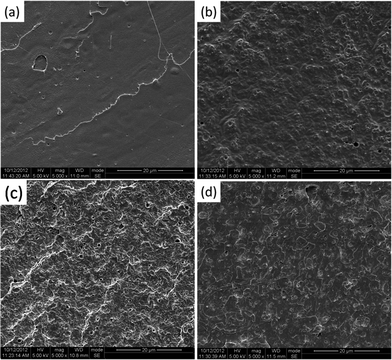 | ||
| Fig. 8 SEM images of cryofractured surfaces for neat PLLA (a), PLLA/LPU (b), PLLA/CPU10 (c), and PLLA/CPU30 (d). | ||
The phase morphologies of the samples were further observed by TEM. Fig. 9 shows the TEM images of PLLA/LPU and PLLA/CPU blends. As expected that phase separation with the typical droplet-in-matrix structure occurred for all PLLA/CPU blends, while it is interesting to find that phase separation also occurred for PLLA/LPU, in which LPU was composed of PEG and MDI, and the main component was PEG (∼80 wt% on the basis of LPU) which should be miscible with PLLA since it is a plasticizer for PLLA. The phase separation may be caused by the aggregation of MDI component. As its content is small, the formed dispersed phase size is very small with weight-average particle diameter (dw) of 0.26 μm. The values of dw for dispersed CPU phases for PLLA/CPU blends showed uptrend with increasing glycerol content with the values of 0.72, 0.76, 1.13, 1.47, and 1.32 μm for PLLA/CPU5, PLLA/CPU10, PLLA/CPU15, PLLA/CPU20, and PLLA/CPU30, respectively. It is reasonable since the content of hard segment increased with glycerol content, and the hard segment is immiscible with PLLA matrix. It is reported that the size of dispersed phase plays a crucial role in notched impact strength.42–44 So, the relationships between glycerol content, dispersed phase diameter, and notched impact strength are schematically shown in Fig. 10. We can see that the notched impact strength increased first and then decreased with increasing CPU phase diameter or glycerol content. The optimum CPU phase diameter for high notched impact strength was around 0.7 μm as in the cases of PLLA/CPU5 and PLLA/CPU10, which is in agreement with the results obtained in other toughened PLLA systems.37 The results suggest that the notched impact strength of PLLA blends can be well tailored by CPU dispersed phase diameter which can be controlled by the composition of CPU.
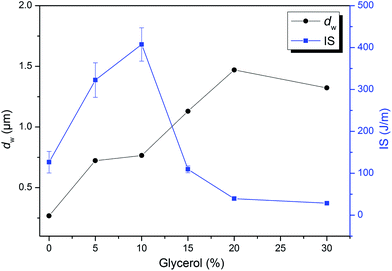 | ||
| Fig. 10 The weight-average particle diameter (dw) and notched impact strength (IS) of PLLA/CPU blends as a function of glycerol content. | ||
It is interesting to find that when the content of glycerol was less than 15 wt%, the phase separation was observed for dispersed CPU phase, as evidenced by the formation of dark subdomains in the center of dispersed CPU particle, which is reasonable since the CPU is a polyurethane consisting of hard and soft segments, and the two segments are immiscible thus to form phase separation. The inner dark subdomains was formed by aggregation of hard segments while the outer light subdomains was the soft PEG segments, since PEG is miscible with PLLA thus PEG segments are more affinitive with PLLA than the hard segments. However, when the content of glycerol increased to more than 15 wt%, the phase separation in CPU phase cannot be observed, which was caused by the fact that the content of hard segments is so high that the phase separation was almost prohibited. The occurrence of phase separation of CPU was helpful for reinforcing the physical properties of PLLA/CPU blends, because the interfacial compatibility between PLLA and CPU can be improved by the affiliation of outer PEG segments and PLLA matrix, which should be another reason that the notched impact strength decreased significantly when the content of glycerol increased to more than 15 wt%.
4. Conclusions
Super-tough PLLA/CPU blends were successfully prepared by reactive blending of PLLA with PEG, glycerol, and MDI. Both the elongation at break and notched impact strength of PLLA were dramatically improved by formation the blends with CPU dispersed in PLLA matrix. The interfacial compatibilization occurred between PLLA and CPU by reaction of hydroxyl group of PLLA and isocyanate group of MDI. The crosslinking density and gel fraction of CPU increased while the swelling ratio decreased with increasing glycerol content. The morphology of the blends depends strongly on the composition of CPU, the size of dispersed CPU increased gradually with increasing glycerol content, and the notched impact strength increased first and then decreased with increasing CPU phase diameter. The optimum diameter for high notched impact strength was found to be ∼0.7 μm when the content of glycerol was in the range 5–15 wt%. In a word, the notched impact strength of the PLLA blends can be well tailored by the composition of CPU.Acknowledgements
This work has been supported by National Natural Science Foundation of China (20904034 and 51121001), the Program of International S & T Cooperation (2011DFA51420), and the Program for Changjiang Scholars and Innovative Research Teams in University of China (IRT 1026).References
- T. Mekonnen, P. Mussone, H. Khalil and D. Bressler, J. Mater. Chem. A, 2013, 1, 13379–13398 CAS.
- K. Sudesh and T. Iwata, Clean: Soil, Air, Water, 2008, 36, 433–442 CrossRef CAS.
- L. Yu, K. Dean and L. Li, Prog. Polym. Sci., 2006, 31, 576–602 CrossRef CAS PubMed.
- D. J. Darensbourg, Chem. Rev., 2007, 107, 2388–2410 CrossRef CAS PubMed.
- F. S. Guner, Y. Yagci and A. T. Erciyes, Prog. Polym. Sci., 2006, 31, 633–670 CrossRef PubMed.
- A. Gandini, D. Coelho, M. Gomes, B. Reis and A. Silvestre, J. Mater. Chem., 2009, 19, 8656–8664 RSC.
- A. K. Mohanty, M. Misra and L. T. Drzal, J. Polym. Environ., 2002, 10, 19–26 CrossRef CAS.
- T. Maharana, B. Mohanty and Y. S. Negi, Prog. Polym. Sci., 2009, 34, 99–124 CrossRef CAS PubMed.
- R. M. Rasal, A. V. Janorkar and D. E. Hirt, Prog. Polym. Sci., 2010, 35, 338–356 CrossRef CAS PubMed.
- J. B. Zeng, Y. D. Li, Q. Y. Zhu, K. K. Yang, X. L. Wang and Y. Z. Wang, Polymer, 2009, 50, 1178–1186 CrossRef CAS PubMed.
- L. Xiao, Y. Mai, F. He, L. Yu, L. Zhang, H. Tang and G. Yang, J. Mater. Chem., 2012, 22, 15732–15739 RSC.
- H. Z. Liu and J. W. Zhang, J. Polym. Sci., Part B: Polym. Phys., 2011, 49, 1051–1083 CrossRef CAS.
- T. Yokohara and M. Yamaguchi, Eur. Polym. J., 2008, 44, 677–685 CrossRef CAS PubMed.
- M. Shibata, Y. Inoue and M. Miyoshi, Polymer, 2006, 47, 3557–3564 CrossRef CAS PubMed.
- M. Shibata, N. Teramoto and Y. Inoue, Polymer, 2007, 48, 2768–2777 CrossRef CAS PubMed.
- M. E. Broz, D. L. VanderHart and N. R. Washburn, Biomaterials, 2003, 24, 4181–4190 CrossRef CAS.
- N. Lopez-Rodriguez, A. Lopez-Arraiza, E. Meaurio and J. R. Sarasua, Polym. Eng. Sci., 2006, 46, 1299–1308 CAS.
- V. Vilay, M. Mariatti, Z. Ahmad, K. Pasomsouk and M. Todo, J. Appl. Polym. Sci., 2009, 114, 1784–1792 CrossRef CAS.
- S. Iannace, L. Ambrosio, S. J. Huang and L. Nicolais, J. Appl. Polym. Sci., 1994, 54, 1525–1535 CrossRef CAS.
- Y. Takagi, R. Yasuda, M. Yamaoka and T. Yamane, J. Appl. Polym. Sci., 2004, 93, 2363–2369 CrossRef CAS.
- L. Jiang, M. P. Wolcott and J. W. Zhang, Biomacromolecules, 2006, 7, 199–207 CrossRef CAS PubMed.
- K. Li, J. Peng, L. S. Turng and H. X. Huang, Adv. Polym. Technol., 2011, 30, 150–157 CrossRef CAS.
- Y. J. Li and H. Shimizu, Macromol. Biosci., 2007, 7, 921–928 CrossRef CAS PubMed.
- J. B. Zeng, Y. D. Li, Y. S. He, S. L. Li and Y. Z. Wang, Ind. Eng. Chem. Res., 2011, 50, 6124–6131 CrossRef CAS.
- R. Bhardwaj and A. K. Mohanty, Biomacromolecules, 2007, 8, 2476–2484 CrossRef CAS PubMed.
- Y. Li and H. Shimizu, Eur. Polym. J., 2009, 45, 738–746 CrossRef CAS PubMed.
- G. Singh, H. Bhunia, A. Rajor, R. N. Jana and V. Choudhary, J. Appl. Polym. Sci., 2010, 118, 496–502 CrossRef CAS.
- K. Nunez, C. Rosales, R. Perera, N. Villarreal and J. M. Pastor, Polym. Eng. Sci., 2012, 52, 988–1004 CAS.
- L. Han, C. Han and L. Dong, Polym. Int., 2012, 62, 295–303 CrossRef.
- A. J. Nijenhuis, E. Colstee, D. W. Grijpma and A. J. Pennings, Polymer, 1996, 37, 5849–5857 CrossRef CAS.
- J. S. Qiu, C. Y. Xing, X. J. Cao, H. T. Wang, L. Wang, L. P. Zhao and Y. J. Li, Macromolecules, 2013, 46, 5806–5814 CrossRef CAS.
- C. H. Ho, C. H. Wang, C. I. Lin and Y. D. Lee, Polymer, 2008, 49, 3902–3910 CrossRef CAS PubMed.
- Z. Su, Q. Li, Y. Liu, G. H. Hu and C. Wu, Eur. Polym. J., 2009, 45, 2428–2433 CrossRef CAS PubMed.
- W. Zhang, L. Chen and Y. Zhang, Polymer, 2009, 50, 1311–1315 CrossRef CAS PubMed.
- H. T. Oyama, Polymer, 2009, 50, 747–751 CrossRef CAS PubMed.
- W. Y. Dong, F. H. Jiang, L. P. Zhao, J. C. You, X. J. Cao and Y. J. Li, ACS Appl. Mater. Interfaces, 2012, 4, 3667–3675 CAS.
- H. Z. Liu, W. J. Song, F. Chen, L. Guo and J. W. Zhang, Macromolecules, 2011, 44, 1513–1522 CrossRef CAS.
- H. Z. Liu, F. Chen, B. Liu, G. Estep and J. W. Zhang, Macromolecules, 2010, 43, 6058–6066 CrossRef CAS.
- G. C. Liu, Y. S. He, J. B. Zeng, Y. Xu and Y. Z. Wang, Polym. Chem. 10.1039/c3py01649h.
- A. J. Oshinski, H. Keskkula and D. R. Paul, Polymer, 1996, 37, 4891–4907 CrossRef CAS.
- S. F. Edwards, H. Takano and E. M. Terentjev, J. Chem. Phys., 2000, 113, 5531–5538 CrossRef CAS PubMed.
- L. Corte and L. Leibler, Macromolecules, 2007, 40, 5606–5611 CrossRef CAS.
- C. B. Bucknall and D. R. Paul, Polymer, 2009, 50, 5539–5548 CrossRef CAS PubMed.
- C. B. Bucknall and D. R. Paul, Polymer, 2013, 54, 320–329 CrossRef CAS PubMed.
| This journal is © The Royal Society of Chemistry 2014 |

